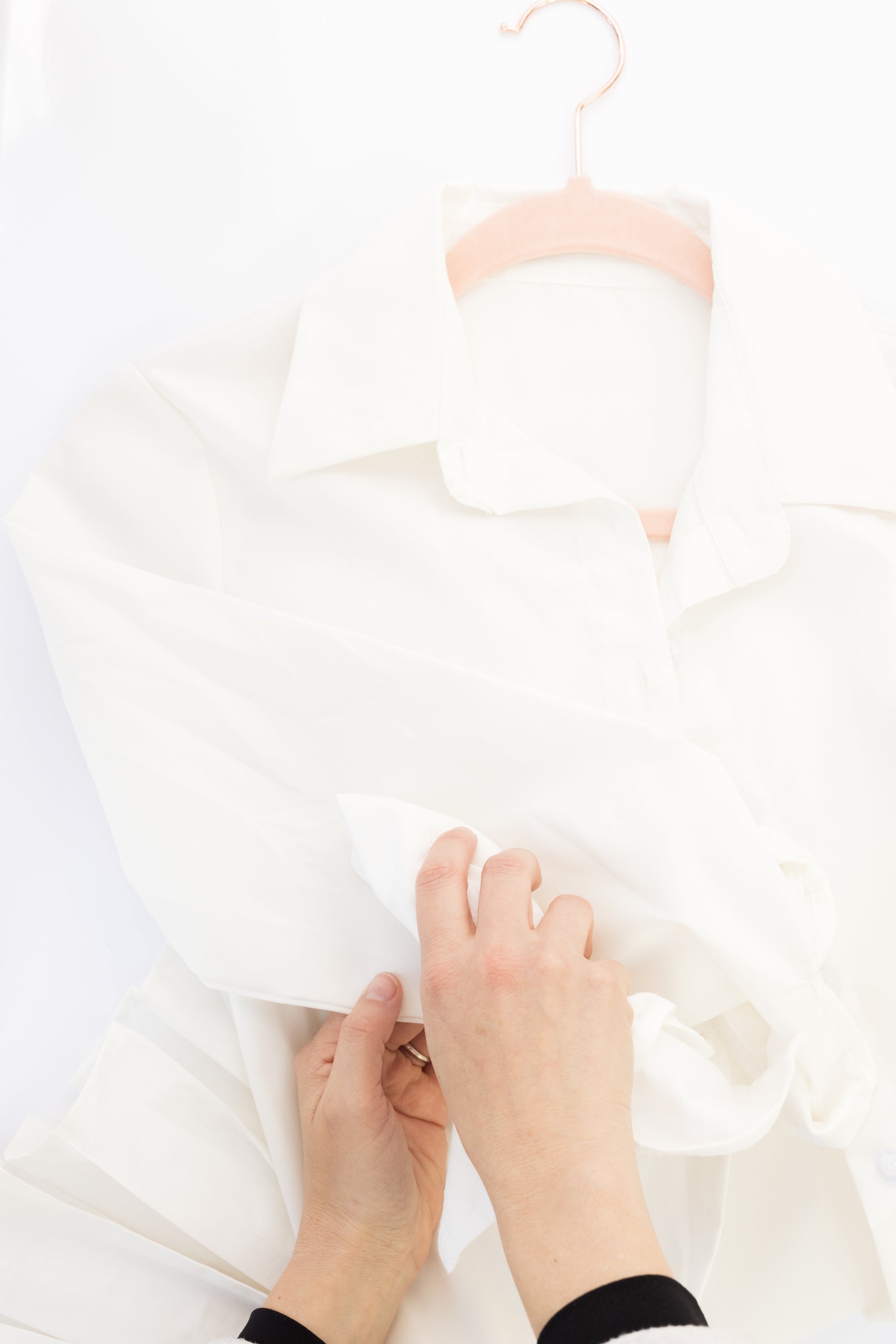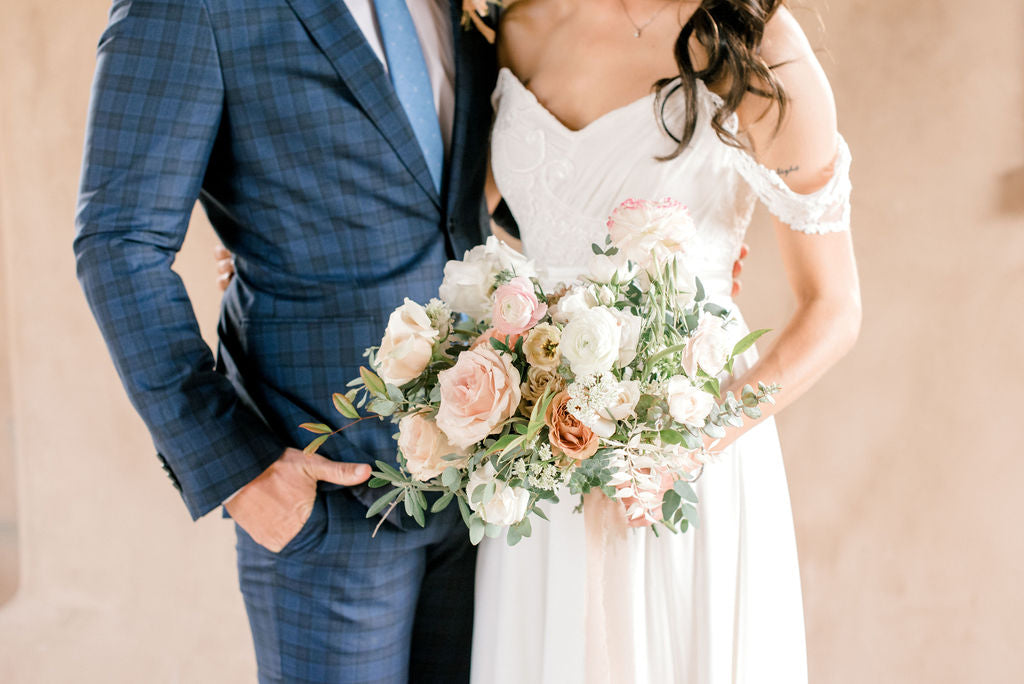
Removing Stains on your Wedding Day
Let's face it- a stain on your wedding attire is less than ideal. A big splash of red wine on your gorgeous white dress?? No thanks. Fortunately, there are simple ways to tackle stains, especially if they have just occurred. In The Signature Bride Kit you will find our Stain Removing Spray, which we think is nothing short of miraculous. It was originally formulated for a hematology lab, so it is incredibly powerful! If you don't have The Bride Kit (what are you waiting for?) or you have a little extra time to tackle the stain, read on!
We've compiled a comprehensive list of the fabrics you will typically see used with wedding gowns, bridesmaids dresses, tuxedos, and suits, and then the best methods for getting stains out. Best of luck for a stain-free wedding journey!
Wedding dresses, bridesmaids dresses, tuxedos, and suits are all typically made from a variety of different fabrics, with the following being what we see the most....
Wedding dresses:
- Satin: This fabric is shiny and has a smooth finish, it is often used for the bodice and skirt of a wedding dress.
- Organza: This is a lightweight and sheer fabric, which is often used for the overlay of a wedding dress.
- Chiffon: This is a lightweight and flowy fabric that is often used for the overlay of a wedding dress.
- Lace: This is a delicate and often intricate fabric that is can be used as an overlay or as an embellishment on a wedding dress. This is the most likely to be passed down or repurposed, and can often be extremely fragile.
- Tulle: A lightweight, very fine netted fabric that gives a full and fluffy skirt for a wedding dress.
- Taffeta: this fabric is a crisp and smooth fabric, often used for the overlay.
Bridesmaids dresses:
- Chiffon: This is a lightweight, flowy fabric that is often used for bridesmaid dresses. often times as an overlay.
- Satin: This fabric is shiny and has a smooth finish, thicker than chiffon but still with good movement.
- Taffeta: this fabric is a crisp and smooth fabric, often used for the overlay of bridesmaids dresses, or dresses that are very structured.
- Tulle: A lightweight, very fine netting fabric that gives a full and fluffy skirt. For a bridesmaid dress this would typically be found as a layering piece under the skirt.
- Polyester: This is a strong, durable, and wrinkle-resistant fabric that is often used for bridesmaid dresses in cooler temperatures.
Tuxedos:
- Wool: This is a traditional and classic fabric that is often used for tuxedos. It's both wrinkle-resistant and suitable for most weather conditions.
- Microfiber: This fabric is a synthetic fabric that mimics the look and feel of wool, it is often used for tuxedos because of its wrinkle-resistance and durability.
Suits:
- Wool: This is a traditional and classic fabric that is often used for suits. It's both wrinkle-resistant and suitable for most weather conditions.
- Polyester: This is a strong, durable, and wrinkle-resistant fabric that is often used for suits.
- Microfiber: This fabric is a synthetic fabric that mimics the look and feel of wool, it is often used for suits because of its wrinkle-resistance and durability.
- Linen: This fabric is breathable and lightweight, it's typically used for summer suits.
It's worth noting that there're a lot of variations with fabrics, depending on the season, region, personal preferences, and budget. Designers often have their own preference as well, and may have other materials they like to work with that are not listed here!
Here's our best advice for getting stains out, material by material.
Silk, Satin, Chiffon, Lace, Organza, Chiffon, Tulle, Rayon, and Taffeta:
- If you have The Bride Kit, there are included alcohol wipes. Alcohol is known to help break down oil based stains, and dries very quickly, which helps avoid the dreaded water ring that is often left on delicate fabrics. Always do a spot test in an inconspicuous area first, especially if the fabric is not white. When using the alcohol wipe, first dab the stain with a damp (not soaking wet) cloth if possible to remove any residue. There is a cotton towel also included in The Bride Kit that is perfect for this purpose. Working from the inside out, gently blot the stained area with the alcohol wipe and sweep in an outward, circular direction. The goal is to break down the stain using the least amount of force as possible so as not to damage the material. Keep working gently but firmly until the stain is gone. Allow the area to air dry.
- If you do not have alcohol wipes, use a small amount of white vinegar and water to gently blot the area.
- Avoid using hot water, as it can cause the material to shrink or become discolored.
- If the stain is still present, use a mixture of mild detergent and cool water to gently blot the stain, again using caution to not soak the material, which may cause a water ring or water stain.
Cotton, Polyester, Microfiber, and Linen:
- If you have The Bride Kit, use the Stain Removing Spray included in your kit. Spray the stained area and use the included cotton cloth to work the stain out. Once the stain has dissolved, use a damp cloth to blot the area. The stain removing formula is very powerful and will continue to work, potentially lifting color from a dyed garment. Allow to air dry.
- If you do not have access to the Stain Removing Spray, use a small amount of dish soap and warm water. Continue the same process as outlined above.
Wool:
- Gently blot the stain with a mixture of mild detergent and cool water.
- Avoid using hot water, as it can cause the wool to shrink.
- If the stain is still present, use a small amount of white vinegar and water to gently blot the area.
Keep in mind that it's always best to address a stain as soon as possible, as fresh stains are usually easier to remove than set-in stains. If a stain persists, it is suggested to take to professional cleaner. And always read the care label of your garments before applying any method outlined above on the fabrics.
In addition, it's always a good idea to test a small, inconspicuous area of the fabric first before attempting to remove a stain to ensure that the method you are using will not cause discoloration or damage to the fabric.
Happy styling!


